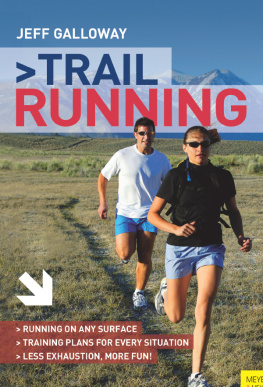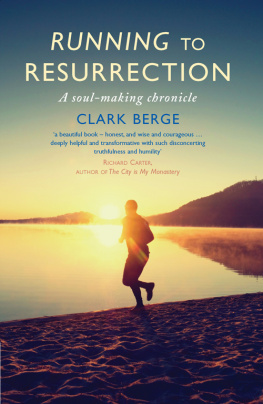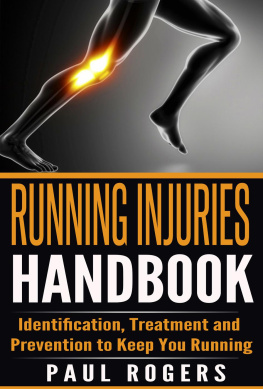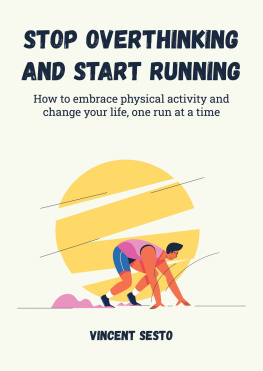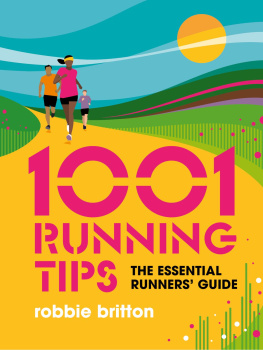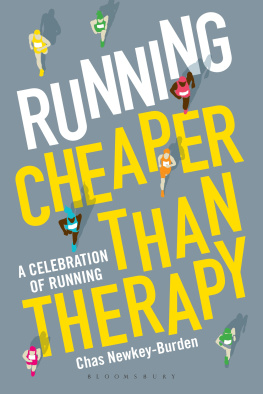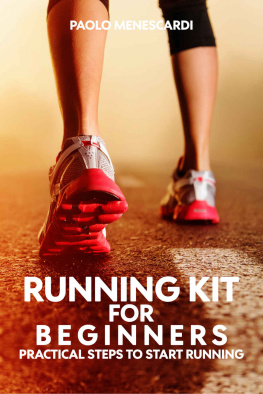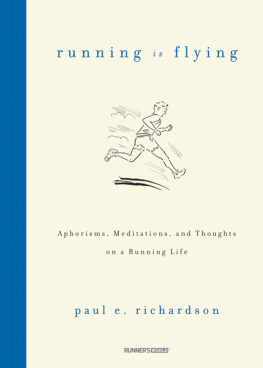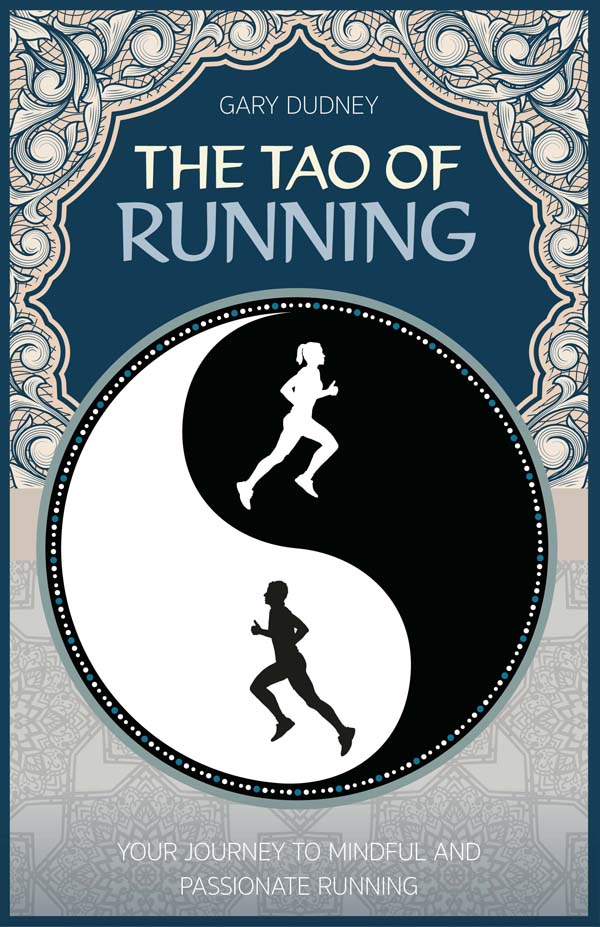
Gary Dudney
The Tao of Running
The Journey to Mindful and Passionate Running
Meyer & Meyer Sport (UK) Ltd.

Contents
Imprint
2016 by Meyer & Meyer Sport (UK) Ltd.
Aachen, Auckland, Beirut, Cairo, Cape Town, Dubai, Hgendorf, Hong Kong, Indianapolis, Manila, New Delhi, Singapore, Sydney, Teheran, Vienna
Member of the World Sport Publishers Association (WSPA)
978-1-78255-406-6
www.m-m-sports.com
www.dersportverlag.de
ISBN 978-1-78255-406-6
For Cassie, Barney, Hobbs, Jubilee, Bonkers, Sebastian, Hermes, and Patches: They showed me the Way.
And many thanks to those who have shared the many miles of trails with me: David Nakashima, Jeff Harber, Richard Schwarz, Karen Cruz, Kathleen Bortolussi, Robert Josephs, and especially my excellentfriend, Rob Mann
The contents of this book were carefully researched. However, all information is supplied without liability. Neither the author nor the publisher will be liable for possible injuries or damages resulting from thisb book.
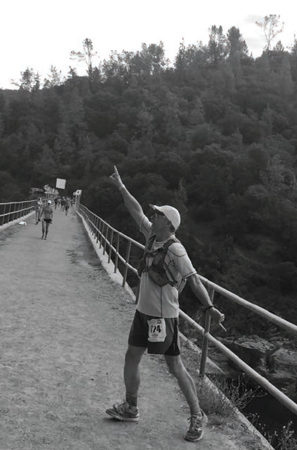
The author temporarily overwhelmed with the joy of running while crossing the famous No Hands Bridge at the Western States 100 Mile Endurance Run.
Rob Mann
Prologue
Jumping Off
A good traveler has no fixed plans and is not intent on arriving.
From Lao Tzu, Tao Te Ching
Imagine for a moment that you take a chair from your dining room and position it in the center of your living room. Now take off your shoes and step up on the chair. Watch your balance. Now jump off the chair onto the carpet, or, if youre landing on a hardwood floor, bend your knees a little more to cushion the blow.
That wasnt such a big deal, was it? It didnt require you to think about it much. You didnt get emotionally invested in it. It wasnt much of a commitment. It didnt involve summoning much passion on your part. It certainly didnt change your life, although if anybody was watching, they might have been looking at you a little funny.
Now imagine a second jump except this time youre going to jump from a platform on a bridge that spans a deep river gorge. Its going to be a bungee jump. You stand there waiting in a fever pitch. You feel the wind on your face. You feel your heart beating in your chest. Light pours down from a glaring sun. The gorge under you is monstrous. All your senses are ultra sharp. You can pick out streaks of white water on the surface of the blue river rushing far below as if you were inspecting it through a telescope. The cars that roar by on the bridge behind you sound like raging locomotives. You smell the exhaust from their engines.
Now you feel the harness being tightened around you, the carabineers snapping into place. The whole world narrows down to a single focal point: your intense and monolithic commitment to jump. It is like nothing else has ever happened in your life, and nothing else ever will. Everything is all right now. You summon all your passion, hear the final countdown, feel vast emotions wash over you, and then you step off the platform completely and utterly in the moment. You exit the life you had before the bungee jump and enter your new life, the one after the bungee jump.
Now here is the point. The running experiences you are having right now are like jumping off the chair in your living room. The running experiences you are going to have after you read this book will be like the bungee jump. You are going to learn how to think about running and how to appreciate all of the rich possibilities inherent in running.
And it doesnt matter what kind of runner you area casual jogger, a solid 10K performer, a trail runner, a mud runner, a multi-time marathon finisher, a Spartan runner, an ultrarunnereveryones running experience will be transformed and enhanced. Youll learn to bring passion, emotion, and total commitment to your running. Youll learn to be fully present in the moment, to live fully in the world, to run with the Tao.
Running is more than the sum of its parts. The physical side of it is pretty straightforward, but the psychological, the emotional, the philosophical dimensions of running are not as obvious. This book will deepen your understanding of those aspects of running, show you how running connects with the broader passions and aspirations in your life, and teach you how running can help you cope with lifes challenges. Youll be motivated to run, eager to run, and ready to use running to transform your life.
In these pages, youll explore how running connects with mindfulness, positivity, relaxation, the philosophy of existentialism, the concept of the Tao, the naturalistic elements of Buddhism, and other areas of life such as friendships. Each new perspective will open your eyes to the rich possibilities for self-growth and self-awareness that can be found in running. Youll learn new ways to think about goals and what is really important in the process of setting and achieving goals. Youll learn how to cope with the special demands of racing. Youll see how the friendships you make while running are unique. Youll discover the special benefits of trail running and learn how to become a trail monster. Youll see how running works for many as a veritable fountain of health and youth.
If running has gotten boring for you or just feels like more work, this book will help you step back and see running in a whole new light. If youve ever flagged during a workout, lost your will, broken down in a marathon, or even dropped out of a race, this book will give you so many ways to stick with the program when the going gets tough that your problem will be deciding which one to use.
So never mind the dining room chair. Get yourself out of the living room and out the door. Get into the sunlight, feel the wind on your face, summon your passion. Then dont just step off that platform, leap off of it into the clear air.
Why the Tao of Running?
There is a traditional subject matter in Chinese painting of the three vinegar tasters. One interpretation of this subject matter holds that the three tasters represent the three great Chinese religions: Confucianism, Buddhism, and Taoism. The Confucian taster reacts to the vinegar with a sour expression, supposedly signifying how his philosophy finds life sour since the present is thought to be out of step with the past. The Buddhist reacts with a bitter expression because life, according to his philosophy, is bitter in that it is full of pain and suffering. But the Taoist tastes the vinegar and takes on a sweet expression. Sweet?
For the Taoist, the taste of the vinegar is not the issue. The Taoist recognizes that the vinegar is simply being vinegar; it is being true to its nature in the natural order of things, which for a Taoist is intrinsically good. By experiencing the vinegar as it is, non-judgmentally, the Taoist himself is recognizing and participating in the flowing and harmonious universe that Taoism posits.
A key goal of Taoism is to fit into this harmonious flow in our approach to all things and in all our actions. A Taoist has a particular way of appreciating and learning from and working with whatever happens in life. Any situation one finds oneself in, like tasting the vinegar, might be unpleasant or it might involve conflict or some disconcerting change, but the Taoist brings an attitude of acceptance to life and recognizes that whatever the situation, this is life just being life and things change and evolve.


